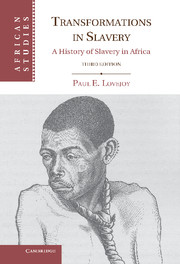Book contents
- Frontmatter
- Contents
- Maps and Tables
- Note on Currencies, Weights, and Measures
- Preface
- Preface to the Second Edition
- Preface to the Third Edition
- 1 Africa and Slavery
- 2 On the Frontiers of Islam, 1400–1600
- 3 The Export Trade in Slaves, 1600–1800
- 4 The Enslavement of Africans, 1600–1800
- 5 The Organization of Slave Marketing, 1600–1800
- 6 Relationships of Dependency, 1600–1800
- 7 The Nineteenth-Century Slave Trade
- 8 Slavery and “Legitimate Trade” on the West African Coast
- 9 Slavery in the Savanna during the Era of the Jihads
- 10 Slavery in Central, Southern, and Eastern Africa in the Nineteenth Century
- 11 The Abolitionist Impulse
- 12 Slavery in the Political Economy of Africa
- Epilogue
- Appendix Chronology of Measures against Slavery
- Notes
- Select Bibliography
- Index
- Books in this series
8 - Slavery and “Legitimate Trade” on the West African Coast
Published online by Cambridge University Press: 05 June 2012
- Frontmatter
- Contents
- Maps and Tables
- Note on Currencies, Weights, and Measures
- Preface
- Preface to the Second Edition
- Preface to the Third Edition
- 1 Africa and Slavery
- 2 On the Frontiers of Islam, 1400–1600
- 3 The Export Trade in Slaves, 1600–1800
- 4 The Enslavement of Africans, 1600–1800
- 5 The Organization of Slave Marketing, 1600–1800
- 6 Relationships of Dependency, 1600–1800
- 7 The Nineteenth-Century Slave Trade
- 8 Slavery and “Legitimate Trade” on the West African Coast
- 9 Slavery in the Savanna during the Era of the Jihads
- 10 Slavery in Central, Southern, and Eastern Africa in the Nineteenth Century
- 11 The Abolitionist Impulse
- 12 Slavery in the Political Economy of Africa
- Epilogue
- Appendix Chronology of Measures against Slavery
- Notes
- Select Bibliography
- Index
- Books in this series
Summary
The collision between a Europe that was increasingly, if sometimes reluctantly, committed to the end of slavery and an African political economy rooted in slavery was most pronounced along the coast of West Africa in the nineteenth century. Here slavery had been transformed into an institution affecting the very structure of society, at least in Sierra Leone, along the Gold Coast, and in the Bights of Benin and Biafra. There continued to be areas in Liberia and western Ivory Coast where slavery was relatively marginal, but for the most part the social formation included a mode of production based on slavery, despite great variations between particular slave systems. Occasionally, slave regimes modified specific practices to assuage the principles of missionaries and European diplomats, but more often the antislavery forces themselves compromised. Europeans had to tolerate and sometimes openly support slavery to achieve aims other than the abolition of slavery and the slave trade, unless European public opinion was a factor.
As we have seen in the previous chapter, the export trade in slaves from West Africa continued well into the nineteenth century, with the volume being particularly high until the 1840s. By 1866, 1,350,000 people had embarked on slave ships in the Bights of Benin and Biafra and the long stretch of coast from the mouth of the Volta River to the Senegambia. The Bights alone accounted for 940,000 slaves, or 70 percent of the total. This trade indicates one feature of slavery in coastal West Africa during the nineteenth century: Departures of slaves continued to have an important influence on the region, so that domestic slavery was still under the umbrella of external demand. This meant that institutions of enslavement and slave trading continued to function, despite British efforts to interfere in ocean shipping.
- Type
- Chapter
- Information
- Transformations in SlaveryA History of Slavery in Africa, pp. 160 - 184Publisher: Cambridge University PressPrint publication year: 2011

